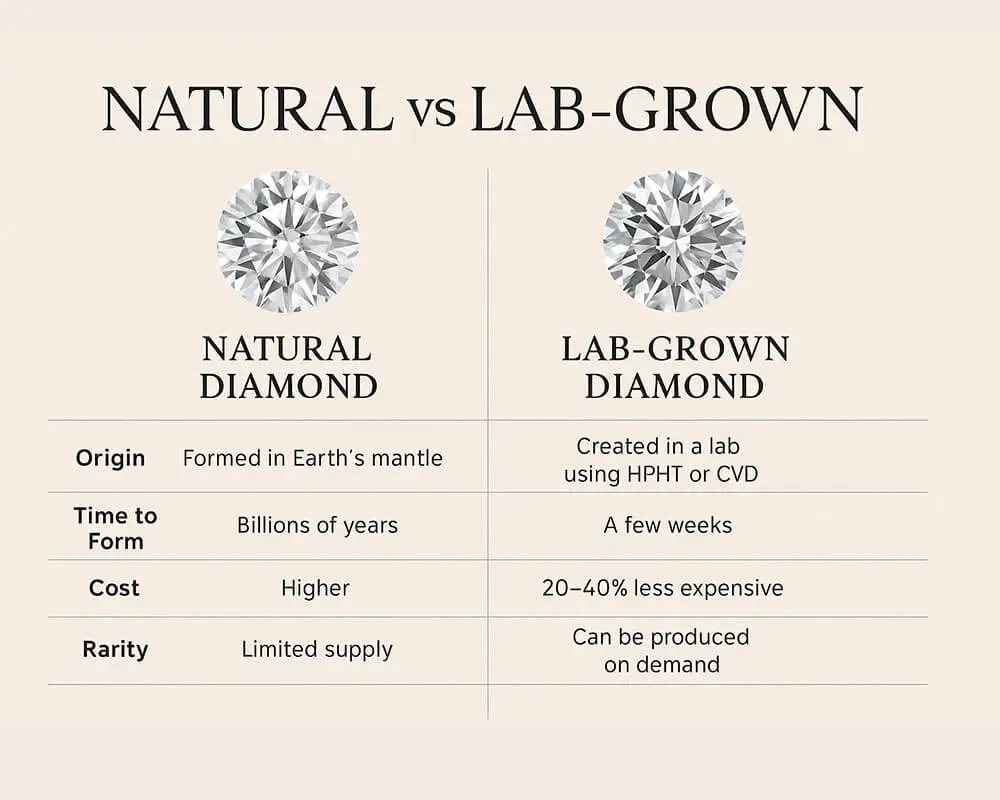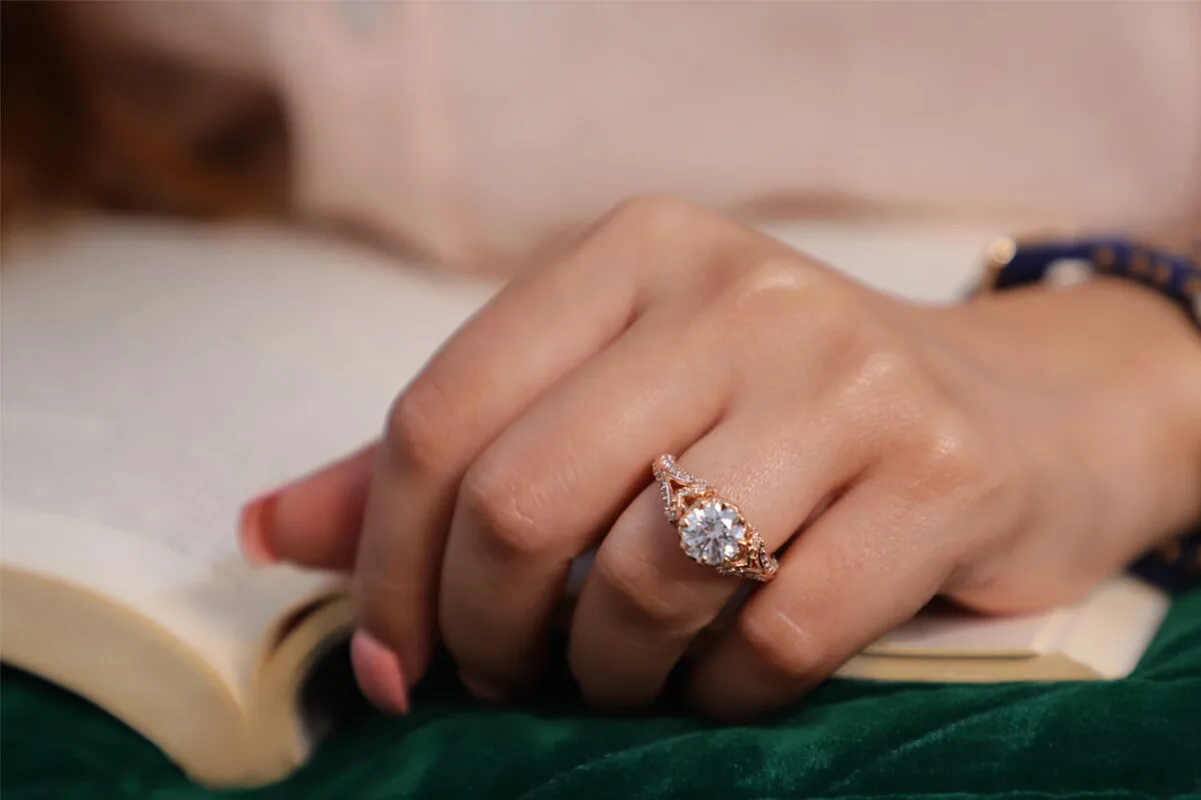Blog
Lab Grown vs Natural Diamonds: Know the Difference Before You Buy

If you have found yourself searching for answers to “lab grown vs natural diamonds” and “lab diamonds vs real diamonds”, you are not alone. As more shoppers have started to research for this comparison understanding the true differences is more important than ever.
Legacy jewellery companies dealing in natural diamond opine that interest in lab grown diamonds is a passing fad – their main argument being that with ongoing advancement in technology prices of lab-grown diamonds will fall to level that of a glass crystal due to mass supply.
New age jewellery companies dealing in lab grown diamonds believe that they have space to co-exist to as their main proposition is making diamond jewellery affordable who otherwise can’t afford natural diamond.
Rossia jewels is a direct- to-consumer diamond jewellery manufacturer and we provide our customers flexibility to get any of our designs made in either lab grown or natural diamond. So below is an unbiased and comprehensive list of important comparison points.
In this guide, we will break down everything you need to know about lab grown vs natural diamonds: from how they are made, to their price difference, eco impact, resale value, and what experts say about investing in each. By the end, you will be equipped to make the right diamond choice for your budget, values, and style.
Lab Grown vs Natural Diamonds: Side-by-Side Comparison on Top 10 key points
| Feature | Lab Grown Diamond | Natural Diamond |
|---|---|---|
| Chemical Composition | Pure carbon | Pure carbon |
| Hardness (Mohs) | 10 | 10 |
| Density | 3.52g/cm³ | 3.52g/cm³ |
| Inclusions | Fewer or different inclusions (can be metallic/graphite) | Unique natural inclusions, like minerals |
| Sourcing | Ethical, sustainable, no mining | Mining required, with possible environmental/social impact |
| Investment/Resale | Lower resale value, not seen as traditional investment | Historically strong demand, can appreciate in value |
| Cost | 30–40% less than comparable natural diamond | More expensive (rarity and mining costs) |
| Formation | Laboratory creation, weeks/months (HPHT/CVD) | Earth’s mantle, millions to billions of years |
| Rarity | Mass-producible, not rare | Geologically rare |
| Sentiment/Heirloom | No geological age, but popular for modern ethics/choice | Deep sense of history, symbolic, often heirloomed |
What Are Natural Diamonds?
Natural diamonds are created deep within the Earth’s mantle over billions of years. These precious stones are formed under intense heat and pressure and reach the surface through powerful volcanic activity. Their origin story makes them incredibly rare — and each one truly unique.
Key Features of Natural Diamonds:
- Formed naturally over billions of years
- Mined from kimberlite rocks or alluvial deposits
- Each diamond has its own natural imperfections, adding character and uniqueness
What Are Lab-Grown Diamonds?
Also known as cultured or man-made diamonds, lab-grown diamonds are created in a controlled laboratory setting. Scientists mimic the Earth’s natural conditions using high-tech methods like High Pressure-High Temperature (HPHT) or Chemical Vapor Deposition (CVD) to grow diamonds from a tiny seed crystal.
Key Features of Lab-Grown Diamonds:
- Made in labs in just a few weeks
- Identical to natural diamonds in chemical and physical structure
- Graded and certified by the same gemological institutes (GIA, IGI, SGL, etc.)
Major Differences Between Lab Grown Diamond and Natural Diamond
1. Origin
- Natural Diamonds: Formed deep underground through natural geological processes
- Lab-Grown Diamonds: Created above ground using advanced lab technologies
2. Cost
- Natural Diamonds: Typically 10x more expensive due to rarity and mining costs
- Lab-Grown Diamonds: Much more affordable — often 60–80% less than natural counterparts
3. Environmental Impact
- Natural Diamonds: Mining can lead to land disruption, water use, and carbon emissions
- Lab-Grown Diamonds: Have a much lower carbon footprint and no mining impact
4. Quality & Purity
- Natural Diamonds: Naturally occurring flaws (inclusions) are common
- Lab-Grown Diamonds: Made under controlled conditions, often resulting in higher clarity
5. Size & Availability
- Natural Diamonds: Large, high-quality stones are rare and expensive
- Lab-Grown Diamonds: Larger sizes and special cuts are more readily available and affordable
6. Certification
Both types are certified by reputable labs (GIA, IGI, SGL etc.) — so you’ll always know the quality of what you’re buying.
7. Market Perception
- Natural Diamonds: Considered traditional, premium, and suitable for heirlooms
- Lab-Grown Diamonds: Gaining popularity among modern buyers who prioritize ethics and value
Why Choose a Natural Diamond?
🔹 Rarity & Long-Term Value
Natural diamonds are rare by nature, which is why they tend to hold their value over time. In fact, prices of natural diamonds have grown an average of 3% annually over the last 35 years.
🔹 Resale Value
Because they are finite in supply, natural diamonds are generally easier to resell than lab-grown ones.
🔹 Legacy & Heritage
Natural diamonds are often chosen for engagement rings and family jewellery meant to be passed down for generations.
🔹 Supports Jobs Worldwide
The natural diamond industry supports over 10 million people globally, contributing to education, healthcare, and infrastructure in mining communities.
Why Choose a Lab-Grown Diamond?
🔹 Ethical Sourcing
Lab-grown diamonds are free from conflict and human rights concerns — a worry sometimes associated with diamond mining in the past.
🔹 Eco-Friendly
These diamonds are much more environmentally conscious, consuming fewer resources and leaving behind a smaller carbon footprint.
🔹 High Quality
Thanks to controlled conditions, lab-grown diamonds often have fewer flaws and higher clarity than their natural counterparts.
🔹 Affordable Luxury
Lab-grown diamonds cost only a fraction of natural diamonds, allowing you to get larger sizes or intricate designs without overspending.
🔹 Endless Design Options
Want a fancy shape or vibrant color? Lab-grown diamonds offer more flexibility in cuts and customization.
🔹 Transparency
Like natural diamonds, lab-grown diamonds come with full certification and grading reports — ensuring authenticity and peace of mind.
Final Thoughts: Which Diamond Is Right for You?
There’s no one-size-fits-all answer — both natural and lab-grown diamonds have their own unique appeal.
Your choice depends on what matters most to you:
✅ Budget-conscious and eco-minded? Lab-grown might be your perfect match.
✅ Looking for a timeless, rare gemstone with heritage value? Go with a natural diamond.
Whether you’re buying an engagement ring, a gift, or a piece of self-love, understanding the differences between lab-grown and natural diamonds helps you pick a stone that truly reflects your values, your style, and your story — with confidence.
Frequently Asked Questions
Are Lab Grown Diamonds Real?
Yes. They have the same chemical, physical, and optical properties as natural diamonds. Only advanced instruments—not the naked eye—can tell the difference.
How Do Prices Compare?
Lab grown diamonds are typically 30–40% less expensive than natural diamonds of similar quality, largely due to the lower cost of production and abundant supply.
Is There a Difference in Appearance?
No. To almost everyone—even jewelry professionals—lab grown and natural diamonds look the same.
Which Is More Environmentally Friendly?
Lab grown diamonds generally cause less environmental damage since they don’t require mining. However, lab production does use significant energy—so true sustainability can depend on the specific producer and their energy sources.
What About Investment Value?
Natural diamonds have historically been seen as a store of value and are often passed down as family heirlooms. The resale market for lab grown diamonds is still developing, and currently these stones tend to have a lower resale or trade-in value.
Are There Differences in Sentimental Value?
That’s subjective. Some people prize the ancient story and rarity of a natural diamond, while others appreciate the modern, ethical appeal of lab grown gems.









